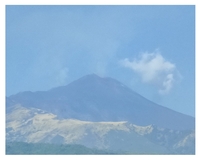 My husband decided it was time for him to go to Sicily and started planning a trip for us. Turns out that Sicilian wineries welcome visitors “Napa Style,” at a price with a reservation. He made a list of the wineries he thought we should visit and started researching. He was able to make and pay for reservations for most of the wineries on his list. Notably, nearly every winery offers not only a tour and tasting, but food as well.
My husband decided it was time for him to go to Sicily and started planning a trip for us. Turns out that Sicilian wineries welcome visitors “Napa Style,” at a price with a reservation. He made a list of the wineries he thought we should visit and started researching. He was able to make and pay for reservations for most of the wineries on his list. Notably, nearly every winery offers not only a tour and tasting, but food as well.
I must admit I was skeptical. I had visions of an Amy Poehler movie like Wine Country, with groups of rowdy party animals. Turned out I was wrong as fellow guests were respectful enthusiasts at every winery we visited.
Over six days we drove the entire length and width of the island and visited six wineries. Following is a snapshot of three of them.
Donnafugata Winery:
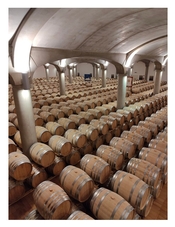 Our first winery appointment was with Donnafugata in Marsala. The Rallo family have been making wines since 1851, when they created a winery and cellar in Marsala. In 1983 Giacomo and Gabriella Rallo decided to modernize their wine operations to demonstrate the potential of Sicilian wines and changed the name to Donnafugata. Today they have five wine estates in different parts of Sicily. Contessa Entellina is a 667-acre estate, named for the hills where they settled in western Sicily. They grow Zibibo grapes on the island of Pantelleria. In Vittoria they make Cerasuolo di Vittoria, the only DOCG in Sicily. Thirty hectares, nearly 74 acres of vines are planted on the north slope of Etna.
Our first winery appointment was with Donnafugata in Marsala. The Rallo family have been making wines since 1851, when they created a winery and cellar in Marsala. In 1983 Giacomo and Gabriella Rallo decided to modernize their wine operations to demonstrate the potential of Sicilian wines and changed the name to Donnafugata. Today they have five wine estates in different parts of Sicily. Contessa Entellina is a 667-acre estate, named for the hills where they settled in western Sicily. They grow Zibibo grapes on the island of Pantelleria. In Vittoria they make Cerasuolo di Vittoria, the only DOCG in Sicily. Thirty hectares, nearly 74 acres of vines are planted on the north slope of Etna.
The winery is quite fashionable, with bright colors on white walls. Some of their labels are designed by the fashion designers Dolce & Gabanna. The 2021 Donnafugata & Dolce& Gabanna Rosa Rosato ($46) made of Nerello Mascalese and Nocera has a light golden rose color, aromas and flavors of red cherry strawberry and notes of rose petals. It is light bodied, smooth, and round in the mouth.
Benanti Winery:
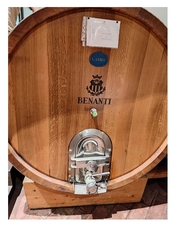 Guiseppe Benanti established the current winery in 1988. He hired Rocco di Stefano, an enologist from Asti, and researched soils, grape varieties, and winemaking techniques-in a quest to make the best Etna wines. After experimenting with Pinot Noir, Chardonnay and Cabernet Sauvignon, he decided these were not the right choice and selected indigenous red varieties: Nerello Mascalese, Nerello Cappuccio and white Caricante. They have vineyards planted on four Etna slopes. Twin brothers Antonio and Savino became owners in 2012. We enjoyed five of their wines accompanied by a five-course lunch.
Guiseppe Benanti established the current winery in 1988. He hired Rocco di Stefano, an enologist from Asti, and researched soils, grape varieties, and winemaking techniques-in a quest to make the best Etna wines. After experimenting with Pinot Noir, Chardonnay and Cabernet Sauvignon, he decided these were not the right choice and selected indigenous red varieties: Nerello Mascalese, Nerello Cappuccio and white Caricante. They have vineyards planted on four Etna slopes. Twin brothers Antonio and Savino became owners in 2012. We enjoyed five of their wines accompanied by a five-course lunch.
COS:
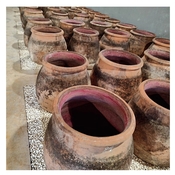 Giambattista Cilia, Cirino Strano, and Giusto Occhipinti established COS winery in 1980 using their initials for their brand name. The winery history goes back to the 1880’s. They farm their vineyards organically and biodynamically. They were certified organic in 2007. With a goal of displaying transparency of the effect of the soil in the wine, Guisto uses 440 liter clay amphorae, neutral botti, and concrete tanks for extended skin contact and ageing. They make Sicily’s only DOCG wine, Cerasuolo di Cerasuolo di Vittoria from Nero d‘Avola and Frappato. The flavors of the 2019 are intense and concentrated, yet light bodied and mouthwatering finishing with chewy tannins ($36)
Giambattista Cilia, Cirino Strano, and Giusto Occhipinti established COS winery in 1980 using their initials for their brand name. The winery history goes back to the 1880’s. They farm their vineyards organically and biodynamically. They were certified organic in 2007. With a goal of displaying transparency of the effect of the soil in the wine, Guisto uses 440 liter clay amphorae, neutral botti, and concrete tanks for extended skin contact and ageing. They make Sicily’s only DOCG wine, Cerasuolo di Cerasuolo di Vittoria from Nero d‘Avola and Frappato. The flavors of the 2019 are intense and concentrated, yet light bodied and mouthwatering finishing with chewy tannins ($36)
In most cases, it is easy for motorists to find the well-marked wineries. Biondi was an exception. Struggling to find the entrance to the un-marked vineyard, we called the winery. It turns out that we were a few feet from the entrance.
C & S Biondi:
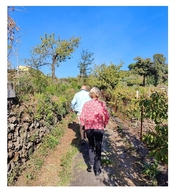 I first met winery owner Ciri Biondi at the Etna Days event. As I wrote in my column about the event, Ciri Biondi, and his ancestors have been making wines since the beginning of the 1900s from vineyards they have owned since the 1600s. One wine stood out to me: Biondi, Etna Bianco DOC “Pianta” 2019 ($41). It was intense and more concentrated than many of the whites I had tasted. I noted that it reminded me of a white Burgundy. He then told me that he had met Aubert de Villaine of Domaine de la Romanée-Conti, who had shared a few white winemaking tips. The Pianta is primarily Carricante with a bit of Catarratto and Minnella fermented and aged in French oak. Ciri and his wife Stepanie welcomed us at their traditional Etna vineyard and winery where my husband, who has made wine nonprofessionally and judged in commercial wine competitions, agreed with the white Burgundy similarity.
I first met winery owner Ciri Biondi at the Etna Days event. As I wrote in my column about the event, Ciri Biondi, and his ancestors have been making wines since the beginning of the 1900s from vineyards they have owned since the 1600s. One wine stood out to me: Biondi, Etna Bianco DOC “Pianta” 2019 ($41). It was intense and more concentrated than many of the whites I had tasted. I noted that it reminded me of a white Burgundy. He then told me that he had met Aubert de Villaine of Domaine de la Romanée-Conti, who had shared a few white winemaking tips. The Pianta is primarily Carricante with a bit of Catarratto and Minnella fermented and aged in French oak. Ciri and his wife Stepanie welcomed us at their traditional Etna vineyard and winery where my husband, who has made wine nonprofessionally and judged in commercial wine competitions, agreed with the white Burgundy similarity.
Contrada: In previous columns I have written about Etna wines, I have struggled to understand the meaning of a contrada, which suggested to me a single vineyard or a cru, but I could not understand how it was defined. I just encountered the term “lava flow age,” which occurs only on active volcanos and led to the creation of the contrata system. A contrata is the Etna version of cru and is meant to single out specific vineyards and lava flows for their unique geologic characteristics.
